Restructuring the Giuseppe Meazza so that it continues to be a top-level stadium you can, despite what Milan and Inter say. In this way there would be no need to build a new stadium next door, there would be a reborn Meazza with its very high iconic personality, no new soil would be wasted, no cement would be added. And all this while saving a lot of money.
Recent history. Milan and Inter last summer announced their intention to join forces and build a new stadium to share. And when mayor Beppe Sala was still in Lausanne anxiously and delicately awaiting the declaration of the IOC regarding the assignment of the 2026 Winter Olympics, Paolo Scaroni of Milan and Alessandro Antonello of Inter, in an at least inelegant move, declared to the press that they were ready to build a new stadium at San Siro, without agreeing with Sala and risking blowing everything up. Fortunately, the Olympic Games were then equally assigned to Milan and Cortina, with the promise that the inauguration would take place at the San Siro stadium. But which San Siro?
Il Milan with balance sheets in deep red it is temporarily held by Paul Singer's American fund Elliott which lent the necessary money to Yonghong Li to buy the club from Silvio Berlusconi. And Inter have been controlled by since 2016 Suning Holdings Group, owned by the Chinese businessman Zhang Jindong.
SUMMER OF FIRE
Between July and September the two clubs - with an impressive media bombardment - presented a dossier on everything that could be done in theSan Siro area, described by Paolo Scaroni as a "desolate land": for only about 15% of the area there were already ready plans for two monumental stadiums chosen by the clubs out of a shortlist of 4, built close to the houses in via Federico Tesio.
For all the remaining 85% – not crumbs then – the clubs envisioned large concrete esplanades with a shopping center, shops, skyscrapers, convention center, business center and hotel, that is the real 'meat' that interests clubs that are unable to earn enough from the proceeds from matches alone. Immediately after the construction of the new stadium, the Meazza would have been demolished, considered obsolete. For a cost divided as follows: 564,6 million for the new stadium, 472,2 million for the so-called recreational center as well as 44 million for the demolition of the Meazza. Total: 1,2 billion.
The media action of the two clubs has dazzled many, enticed by a truly fantastic rendering, worthy of the best Walt Disney production, but it is only rendering. The real data has escaped most people – even just those few that have been disclosed. Starting with the accounts. The concession given by the Municipality to the teams is 90 years. The teams they will pay a rent to the Municipality only from the 33rd year for 5 million a year, against the current 9 million a year.
And on the basis of the proposed projects – for which the Sala junta will vote in the public interest next Friday – the citizens moved, at least those more sensitive to a qualification of the area yes, but in a more harmonious key, less cemented, closer to the identity of the area which has always been centered on greenery.
The main question underlying this whole affair is: but the Meazza is really that old to have to be shot down? Isn't it – even now – the scene of international matches thanks to its excellent characteristics? Maybe some services will be missing. But can't this be remedied with a quality renovation? The teams – already in agreement – with the architects of Populus and Cmr with Sportium say it is not possible.
Instead there are architects capable of responding point by point to the objections of the teams. Three architects have signed three splendid projects that speak of a thorough restructuring of the Meazza, allowing it to maintain its strong iconic personality that made it famous all over the world, adding all the options that international teams need and all the necessary services, letting the teams play even during jobs. Which would eliminate the need to build a new stadium and also that of using the Meazza as a stadium for minor matches. All at significantly lower costs.
Here are the projects.
1- The Vinegar Gallery
Riccardo Aceti, professor of construction techniques at the Milan Polytechnic, together with his students in 2016 thought of an alternative solution to demolition. The Meazza is a symbolic element of sports architecture and engineering and has a uniqueness that must be maintained. We therefore think of a deconstruction of some portions of the third ring with the insertion of elevators in the towers. The bleachers on the other hand – the ones that now cause more problems -, are replaced with an overview gallery closed by windows that look both towards the inside of the stadium and towards the outside with a view of the city. This could be used in various ways, for the construction of commercial and catering spaces, a museum, for a total of 2 square meters of space, i.e. the equivalent of XNUMX football fields.
Il third ring, made for the Italia '90 World Cup, "in recent years it has been used less" says Aceti "so we thought about its reuse, placing a series of services at a height that are usually on the ground floor, a sort of reversal. We would thus create a new element for the Meazza and unique in the world: a panoramic gallery in the "Scala del calcio". After all, the Teatro alla Scala has been modernized leaving the historical part intact.
With this solution the San Siro stadium “it would have about 60 thousand spectators, the same capacity of the new stadium proposed by the teams and the works could be between 24 months and a maximum of 36″, said Aceti. The third tier is independent from the others and this would allow the continuation of the football championship during the works. Furthermore, the renovated Meazza could continue to host concerts, while the new stadiums, according to the projects, music is excluded.
Finally, the works would not interfere with the constraints that the superintendence will want to attribute.
2- Mascheroni's diamond
"The Meazza already has the perfect DNA to be one of the best stadiums in the world": this is how the architect Jacopo Mascheroni begins, who with his studio Jma has taken up the challenge of combining historical and iconic elements of the Meazza with the needs of the teams .
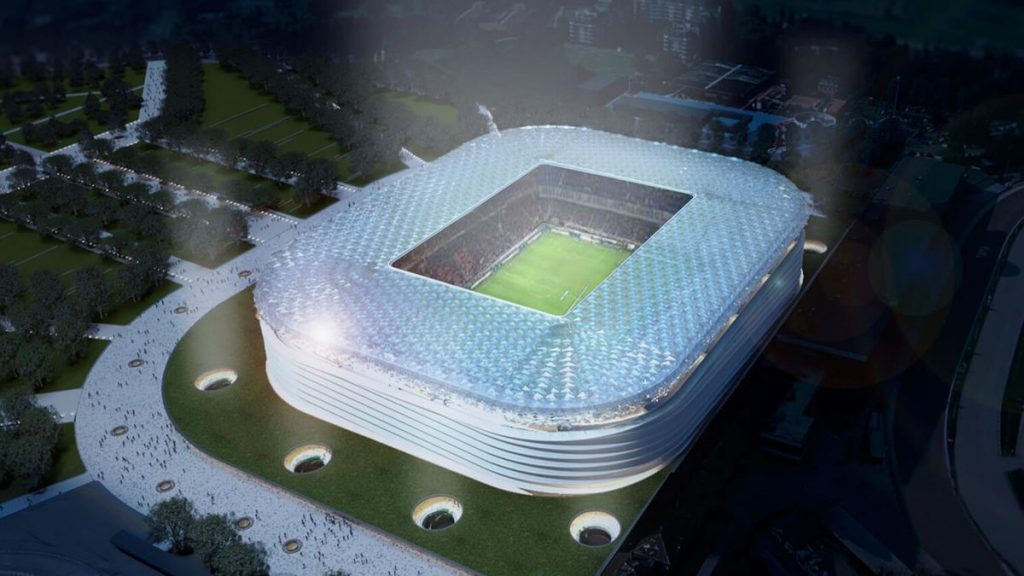
“The renovation project starts from its nerve center, the field, and goes up the ramps up to the second ring in a new style that respects the original value of the structure and its history”, says Mascheroni again, who proposes a restyling of the Meazza in 5 moves:
a- The first intervention defined by us “Ring Zero”, is a design expedient that takes advantage of the distance that today separates the grandstands of the first ring at a raised level from the level of the turf. The simple extension of the bleacher section e the lowering of the pitch by about 2,2 m, brings 3.000 new premium seats. This with two advantages: allowing spectators to experience the event from a new, even more exclusive perspective and complying with UEFA regulations which require the number of premium seats and distances from the perimeter of the field to be increased to 15% of the total.
b- We thought about a diamond cover which protects and enhances the original shape of the stadium, enveloping the bowl-shaped grandstands of the second ring. These are extruded sheets of compact polycarbonate which promote new acoustic comfort both internally (avoiding rumble) and externally, solving the current acoustic pollution of the surrounding houses. Furthermore, with the new proportions of the roof in relation to the height and the openings, the internal microclimate is clearly favored for the benefit of both the maintenance of the turf and the comfort of the spectators.
c- The logics of the rings are inverted e the third ring descends to the lower level: A green platform with a transparent casing that accentuates the security of the entrance system. This New Third Ring follows the footprint of the demolished Third Ring and becomes a light and permeable access and service filter that surrounds the stadium on two levels: the first at zero level, where the turnstiles are located, the second at -1 offers the public a 360-degree experience, a requirement of modern stadiums, while the square in front houses circular skylights to bring light to the lower level.
d- The insufficient services to the public today are implemented thanks to the exploitation of the voids present between the structural pillars that run along the entire external perimeter and the intrados of the two existing rings. New prefabricated floors they will divide these areas to make the most of them by inserting hospitality, food & beverage, sanitation and first aid services.
e- The ramps serving the second ring, which have always been an icon of the Meazza stadium, are brought back to the fore thanks to the demolition of the outer towers. They are also enhanced with the addition of a composite aluminum shaping which softens their shape and accompanies their gesture around the entire perimeter of the stadium.
In the light of these interventions, the Giuseppe Meazza Stadium will go from its current capacity to 61.731 seats, of which 9.500 are premium seats.
Finally, even the red beams that now rest on the upper part of the Meazza will be reused: they will mark a boulevard that will lead from the metro to the "deep" green area with a park area with geothermal plant, rainwater system and other energy devices.
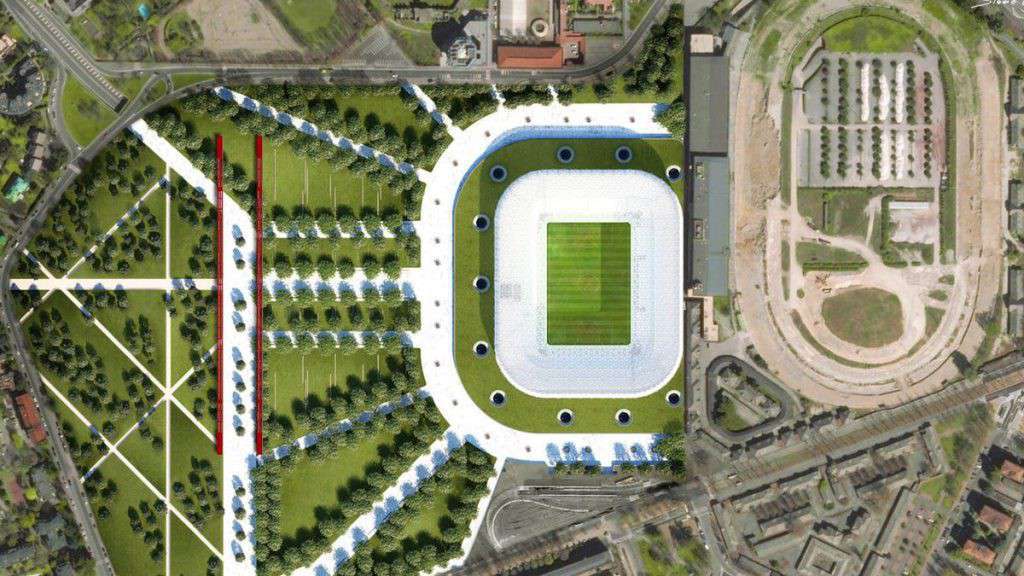
3- The idea of Dontstop
Also Michele Brunello and Marco Brega, studio architects Dontstop, in 2015, on the mandate of Erick Thohir, then Nerazzurri president, had designed the restyling of the San Siro. “It seems trivial, but if the goal is to have a new stadium, San Siro cannot be. But, if the goal is to have a modern stadium that satisfies the needs in terms of hospitality, with a number of seats compatible with the other European teams and services inside the stadium, this is possible at San Siro” they say at Dontstop. The grandstands would be built deeper and, with the recovered space, the necessary hospitality would be available, at the same level as the new Tottenham facility, for example.
“We have to be careful that the stadium doesn't land on the city like a spaceship, without the ability to dialogue with the urban fabric, which San Siro does,” they say. Milan is known for fashion, for the Duomo, but also for San Siro. There is a value that is not commercial, but identity. Making San Siro like a new stadium would be an operation of the highest quality.
Dontstop's project foresaw first the disassembly of the current cover, keeping the four pillars that hold up the red beams and also keeping the red metal beams. Then the complete assembly of the third ring, which the companies open only for very large events and which could hardly host services. Subsequently, the seven towers that do not reach the roof but stop to feed the stands would also have been eliminated. At that point, with capacity reduced to 58 seats, it would have been possible to imagine a new roof, still resting on the beams, but at a lower level, capable of covering the remaining rings.
The second major intervention would have been on the red grandstand: we imagined a progressive demolition of the whole grandstand of the first red tier, maintaining that of the second, and creating a new building wedged under the second tier and, behind it, a series of superimposed floors up to get to the height of the second ring they could hold up to 15.000 mXNUMX of stadium support activities: commercial spaces, media area, hospitality, spaces of excellence and more.
4- Last but not least, Stefano Boeri's projects
Stefano Boeri, one of the greatest exponents of Italian architecture, starting with the Bosco Verticale in Milan, produced both a renovation project for the Meazza a few years ago and a project for a new stadium, which was later rejected by the two clubs. "I always been of the idea that everything must be done to save the San Siro. I have always worked in this direction, to the point that 7-8 years ago I even carried out a project illustrating how the two clubs could coexist better inside the stadium. But even the project of the new stadium – unlike those of Populus and Cma – although rejected by the two teams, at least shows a better respect for the identity of the neighborhood and the surrounding greenery.
Citizens team up
Citizens – residents and non-residents – are moving to try to keep the Meazza in very good shape and to enhance the whole surrounding area. They organized themselves into the San Siro Coordination Committee which brings together all the committees and associations that have always been attentive to compliance with the city's ecological criteria. The City Council last November 28 expressed a positive opinion conditioned by 16 stakes for the projects of the two clubs, adding that the Meazza should not be demolished.
Mayor Sala, who has always been in favor of maintaining the Meazza, also raised a more far-reaching issue: "We are talking not only about a new plant, but of the rethinking of an entire neighborhood. It will take years and we demand guarantees”. The reference to a possible transfer of AC Milan by the Elliott group is clear: “One or both companies could change ownership before the end of the works. Should it happen, we cannot remain with the match in hand". Next Friday the Giunta should decide whether to attribute public interest to the project.
Next to, the Superintendency is moving which identifies in some parts of the Meazza historical elements that could be placed under constraint. "Different types of constraints are being considered, but in any case these would not hinder the complete renovation projects of the Meazza", they tell the Superintendency.
The worst that could happen is that – as some are proposing – the Meazza would be only partially restructured to use it only for minor games, however, building a new stadium next to it. “It would be madness to have two stadiums next to each other! ” they tell the Committee”. It is possible to completely renovate the Meazza. It is useless and harmful to build another stadium next door.
Demolish one by one the objections of the clubs on the restyling of the Meazza
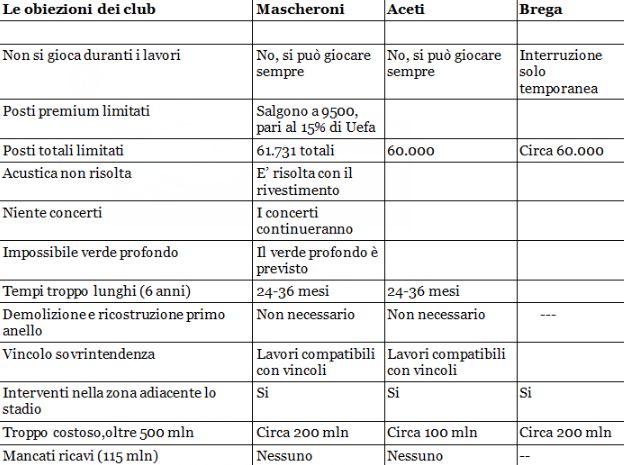
But the projects of the three architectural studios (Mascheroni, Aceti and Brega) dismantle the objections of Milan and Inter one by one. It is possible to redo San Siro without demolishing it.
°°°The author is the President of the San Siro Coordination Committee (comitatocoordinamentosansiro@gmail.com)

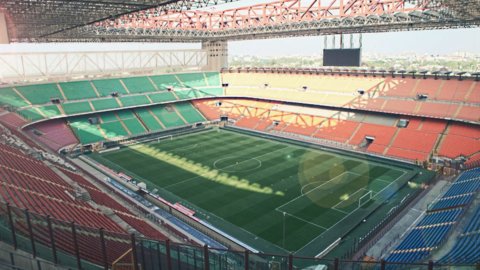
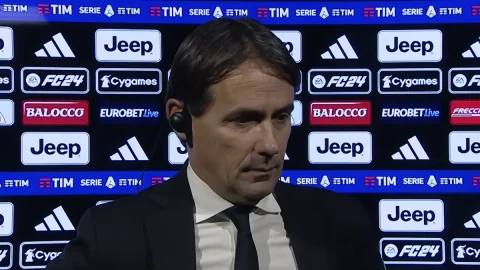

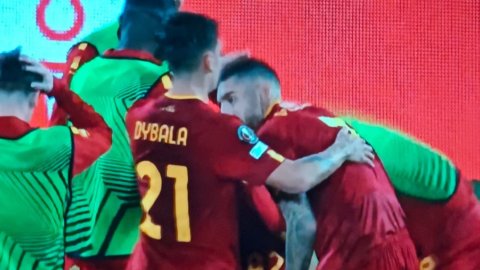

Good evening, my name is Marco F. I'm almost 40 years old, I'm from Turin and I've been an Inter fan since I was 8 years old. I love football and I'm a big fan of stadiums. San Siro can be modernized, I find the project of masks (the diamond of masks) very interesting. I'd like to express other opinions on this, thanks